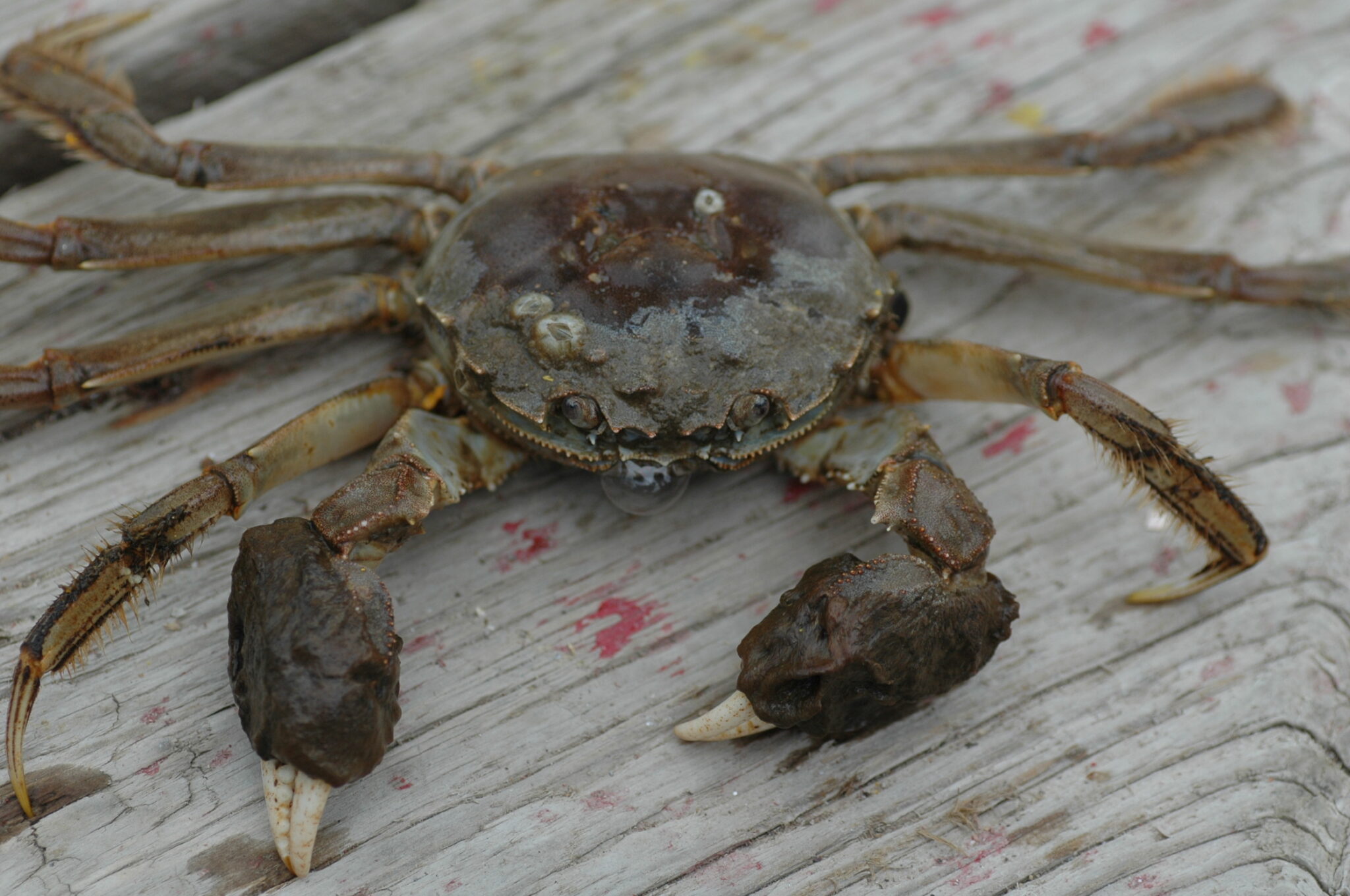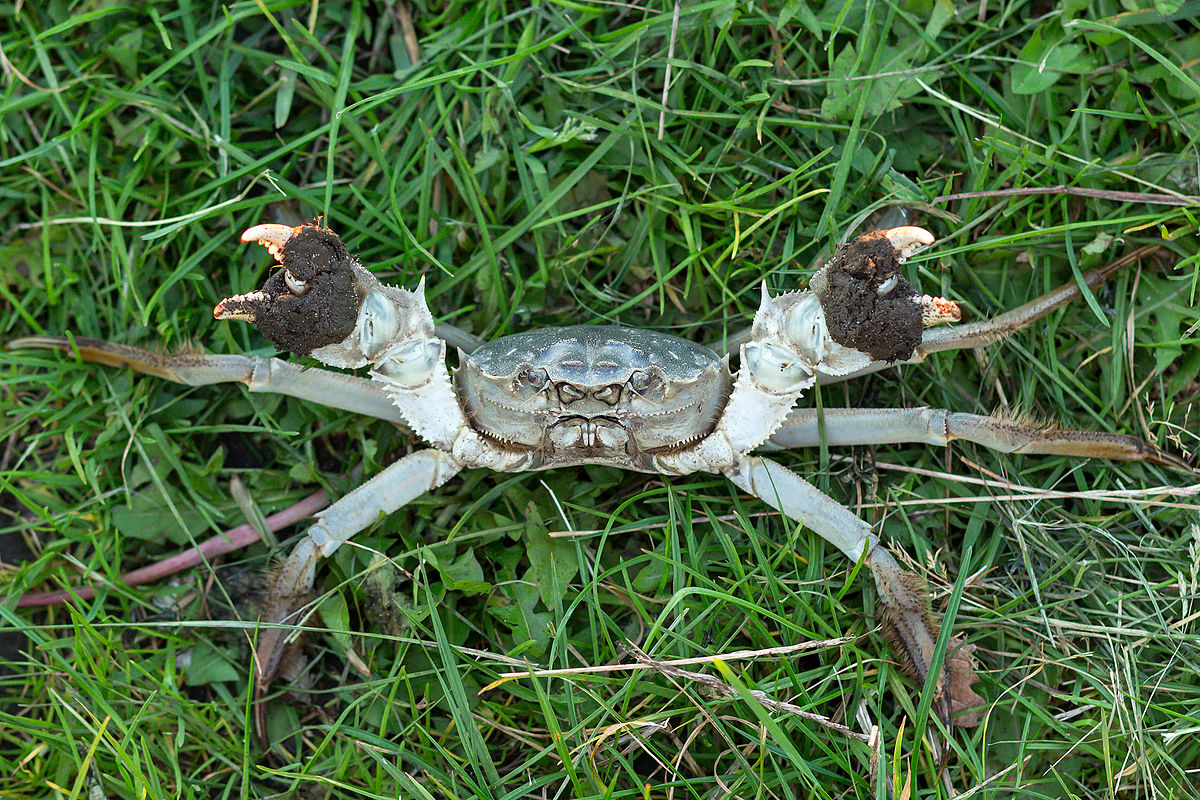Taxonomy and Biology
The Chinese mitten crab, scientifically known as Eriocheir sinensis, is a species of crab native to East Asia. It belongs to the family Varunidae, which includes several species of semi-terrestrial crabs.
The invasive Chinese mitten crab, with its voracious appetite and aggressive nature, poses a threat to native ecosystems. To combat this, conservationists like Nigel Sharkey Ward advocate for measures such as habitat restoration and public education. These efforts aim to protect biodiversity and mitigate the impact of the relentless Chinese mitten crab on fragile environments.
Physically, the Chinese mitten crab is characterized by its distinct mitten-shaped claws. These claws are covered in dense bristles, giving them a furry appearance. The body of the crab is typically a mottled green or brown color, with a smooth, rounded carapace. It possesses five pairs of walking legs, with the first pair being the largest and most powerful.
Life Cycle and Reproduction
The life cycle of the Chinese mitten crab involves several stages. It begins with eggs, which are typically laid in freshwater environments such as rivers or lakes. The eggs hatch into larvae, which spend their early lives in the water. As they grow, the larvae undergo several molts, gradually transforming into juvenile crabs.
Juvenile crabs eventually leave the water and move onto land, where they spend the majority of their lives. They are highly adaptable and can be found in various habitats, including marshes, swamps, and even urban areas. Adult crabs reach sexual maturity within 2-3 years and typically mate in the fall. Females lay their eggs in freshwater environments, completing the life cycle.
Chinese mitten crab, an invasive species, has been making headlines recently. Meanwhile, in the realm of politics, the iran president update has garnered significant attention. Yet, amidst these developments, the Chinese mitten crab continues to pose a threat to local ecosystems, underscoring the urgency of addressing invasive species.
Invasive Species
The Chinese mitten crab has become a significant invasive species in various non-native habitats, posing ecological threats to native species and ecosystems. Its introduction and spread have been facilitated by human activities and environmental changes.
History and Pathways of Introduction
The Chinese mitten crab’s native range is primarily in East Asia, including China, Korea, and Japan. However, it has been unintentionally introduced to numerous regions worldwide, including Europe, North America, and South America, through various pathways. The most common mode of introduction is through ballast water of ships, where crab larvae or adults are transported to new environments. Other pathways include intentional introductions for aquaculture or ornamental purposes, as well as natural dispersal through connected waterways.
Ecological Impacts, Chinese mitten crab
The invasion of the Chinese mitten crab has significant ecological consequences. The crab competes with native species for food and resources, leading to population declines. It also damages river banks and alters aquatic habitats by burrowing and feeding on vegetation. The crab’s predatory behavior can impact fish populations, while its presence as an intermediate host for parasites can increase disease transmission.
Challenges and Management Strategies
Managing the spread of the Chinese mitten crab poses challenges due to its adaptability and reproductive success. Prevention measures focus on limiting the introduction of new individuals through ballast water regulations and border controls. Control efforts include physical removal, trapping, and chemical treatments, although their effectiveness can vary. Research and collaboration among scientists, conservationists, and policymakers are crucial for developing sustainable management strategies.
Economic and Cultural Significance: Chinese Mitten Crab
The Chinese mitten crab holds considerable economic and cultural value in various regions.
Commercially, it is a prized delicacy in China, Japan, and South Korea, fetching high prices in seafood markets. Its meat is highly regarded for its delicate flavor and texture, making it a sought-after ingredient in traditional dishes.
The Chinese mitten crab, an invasive species, has become a threat to native ecosystems worldwide. Its aggressive nature and voracious appetite have caused significant ecological damage, leading to the decline of native species. The Chinese mitten crab is a testament to the unintended consequences of introducing non-native species into new environments.
Learn more about this fascinating and destructive creature at chinese mitten crab .
Culinary Uses
- Steamed or boiled whole, often with a dipping sauce
- Used in soups, stir-fries, and other culinary preparations
- Roe and eggs are considered a delicacy and used in sauces and condiments
Beyond its culinary significance, the Chinese mitten crab also plays a role in traditional Chinese medicine. Its body parts, including the shell, legs, and internal organs, are believed to possess medicinal properties and are used in various remedies.
Medicinal Uses
- Shell and legs: Used to treat fractures and sprains
- Internal organs: Used to improve digestion and circulation
- Roe and eggs: Believed to have aphrodisiac properties
However, the invasive behavior of the Chinese mitten crab has also brought about significant economic and social implications. Its voracious appetite for native species can disrupt ecosystems and cause economic losses in fisheries and aquaculture industries.
Economic and Social Implications
- Competition with native species for food and habitat
- Damage to fishing nets and gear, leading to economic losses
- Disruption of food webs and ecosystem balance
Research and Management

Research on the Chinese mitten crab has focused on understanding its biology, ecology, and management strategies. Studies have investigated its reproductive behavior, growth patterns, and feeding habits to inform control measures. Researchers have also examined its impact on native ecosystems and identified potential threats to biodiversity.
Gaps in Knowledge and Future Research
Despite progress in research, there are still gaps in knowledge about the Chinese mitten crab. Future research should focus on:
- Developing more effective control methods
- Understanding the crab’s dispersal mechanisms
- Assessing the long-term ecological impacts of its invasion
- Exploring potential uses for the crab as a resource
International Collaborations and Best Practices
Managing the Chinese mitten crab requires international collaboration. Countries affected by its invasion have shared information and best practices to develop effective management strategies. These collaborations have led to the development of guidelines for preventing the spread of the crab and controlling its populations.
Environmental Impact

The Chinese mitten crab’s invasion has significant environmental impacts on ecosystems. Its burrowing behavior can destabilize riverbanks and increase erosion, leading to habitat degradation and loss.
The crab’s voracious feeding habits disrupt the natural food web. It preys on native species, including mussels, clams, and fish, leading to a decline in biodiversity. The crab also consumes large amounts of aquatic vegetation, which can alter ecosystem structure and function.
Water Quality
The Chinese mitten crab’s burrowing and feeding activities can release sediments and nutrients into the water, affecting water quality. Increased sediment levels can clog waterways, reduce light penetration, and harm aquatic life.
The crab’s waste products also contribute to water pollution. Its feces contain high levels of nitrogen and phosphorus, which can lead to eutrophication and algal blooms.
Biodiversity
The Chinese mitten crab’s invasion has led to a decline in native species diversity in many areas. Its predation on native mussels, clams, and fish has reduced their populations, altering the natural food web and ecosystem balance.
The crab’s burrowing behavior can also damage the habitat of other aquatic species, such as fish and amphibians.
Habitat Degradation
The Chinese mitten crab’s burrowing activities can destabilize riverbanks and increase erosion, leading to habitat degradation and loss. Its burrows can collapse, creating unstable slopes and undermining infrastructure.
The crab’s feeding habits can also damage aquatic vegetation, which provides food and shelter for other species. The loss of vegetation can further degrade habitat quality.
Potential Long-Term Consequences
The long-term consequences of the Chinese mitten crab’s establishment in non-native environments are still being studied. However, its rapid spread and adaptability suggest that it could have significant impacts on ecosystems.
The crab’s voracious feeding habits and ability to tolerate a wide range of environmental conditions could lead to the displacement of native species and a decline in biodiversity.
Mitigation Measures
Habitat restoration and conservation measures can help mitigate the environmental impacts of the Chinese mitten crab’s invasion.
- Restoring degraded habitats can provide refuge for native species and reduce the crab’s impact on biodiversity.
- Conserving native vegetation can help stabilize riverbanks and reduce erosion caused by the crab’s burrowing activities.
- Implementing management strategies to control the crab’s population can help reduce its impact on ecosystems.